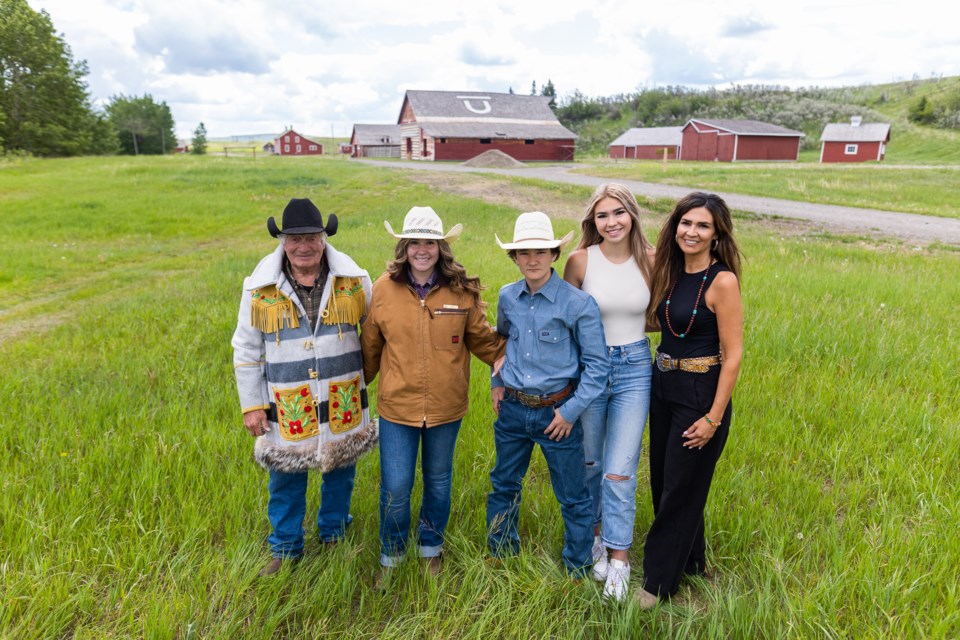A Black Diamond fashion designer has uncovered a heritage she didn’t know existed.
Risa Atkinson says she grew up knowing nothing of her Métis heritage.
Since learning in her 20s that her grandmother was Cree, the mother of three spent the past 15 years educating herself, her children and her relatives about a heritage she didn’t know was hers.
“For 15 plus years I’ve spent a lot of time trying to learn more,” she said. “I keep myself and my kids involved with Métis Nation of Alberta and FMNI (First Nation, Métis and Inuit Initiatives) at the school. My dad’s oldest brother is 93 now and he is so proud of me for doing this and thinks I’m like the family hero for making this okay.”
Atkinson recalls a childhood attending Indian rodeos, her father reading Canadian Indigenous history books and her sister commenting on how their cousins looked native, but it wasn’t until many years later that her father revealed their true background.
“It’s just little things that we just thought were normal, but we didn’t realize until we were older the connection we actually had,” said Atkinson. “We were raised as a white family.”
Atkinson delved further into her family’s heritage recently after entering the Métis Nation of Alberta – Region 3 and Parks Canada capote contest that challenges Métis fashion designers and textile artists to create a capote that reflects their individual heritage for a travelling fashion show in western Canada that will showcase select outerwear designs while sharing Métis stories and culture.
A capote is a handmade wrap-style coat often made from a Hudson’s Bay Company point blanket which dates back to the mid-17th century, worn by First Nations, Métis, French settlers, British settlers, traders, and trappers. The Métis-style capote was hooded, embellished with fringing at the shoulders and neck, and closed with a bright l’Assomption sash.
Atkinson is one of 15 participants in the contest. Five capotes will be selected by a panel of jurors for the show.
Atkinson’s capote, titled The Secret of The Sash, is a true representation of her family’s history.
“I wanted to make sure that my design was going to relate to our family history with Métis and the Hudson Bay,” she said, adding her great-grandfather and great-great grandfather spent most of their lives with the Hudson’s Bay Company. “It was an opportunity for me to find out more information about our Métis Cree history. It sparked conversations in my family when I contacted relatives.”
Atkinson said her father, Ross Fritz, grew up in a home in Saskatchewan where the Cree culture of his mother, Ruby Brass, was rarely spoken about. Fritz’s father, Henry, was of German and Russian descent and didn’t allow Cree to be spoken or Cree stories and traditions to be discussed.
“It was emotional just piecing it all together because I am the one that made this okay for my dad and his siblings to talk about,” said Atkinson. “We’re finally at a place in time where they can share our history. I wanted to put the story in a beautiful way for future generations in my capote design.”
The Secret of the Sash reflects strength, resilience, connection to the land, Atkinson’s family’s cowboy lifestyle, her grandmother’s Cree roots and a touch of femininity.
Atkinson said her grandmother and siblings were victims of the residential school system. Her aunt, Lily, died at residential school after contracting tuberculosis.
“My heart and soul are poured into every stitch, and every hour spent on its creation,” Aktinson said of her capote. “Every time an older relative passes we’re losing more stories and information.”
As the decades pass and more of Atkinson’s family members pass on, she refused to let that heritage go.
She’s teaching her children everything she learns, including having pride in their family background.
Atkinson’s son Holden, 14, was among family members featured in the 2021 Cable Public Affairs Channel documentary Re:Location – the Métis of Alberta. Holden is a two-time junior world saddle bronc champion through the Junior National Finals Rodeo.
Atkinson’s daughter, Taylor, 17, is a dancer with the Calgary Stampede’s The Young Canadians and Kealey, 19, is Miss Teen Southern Alberta. During Kealey’s graduation at Oilfields High School in 2020, she proudly participated in the traditional blanket ceremony held for First Nation, Métis and Inuit grads.
Atkinson’s dad, Ross Fritz, who is a teamster and interpreter at the Bar U Ranch National Historic Site, said he’s proud of how far his daughter has come in restoring pride to his family heritage.
“It was high time it was done,” he said. “I’m very glad that my daughter has gone ahead and done this. Other members of my family, a lot of them are quite pleased about it as well.”
Fritz said he remembers stories his grandfather shared about his Cree childhood.
“He always had a lot of interesting stories to tell us, but we did that mostly when our father wasn’t around,” he said. “There’s so much more I could have learned from my grandfather and even my mother, but my mother talked about it very seldom because she knew our dad didn’t like it. Sometimes when we were alone with our mother she would tell us stories about her growing up.”
Fritz said he never really put much thought into telling his own children about their heritage when they were young.
“It should have been talked about but never was,” he said. “I personally never thought that I should be embarrassed or feel badly about it at all.”



